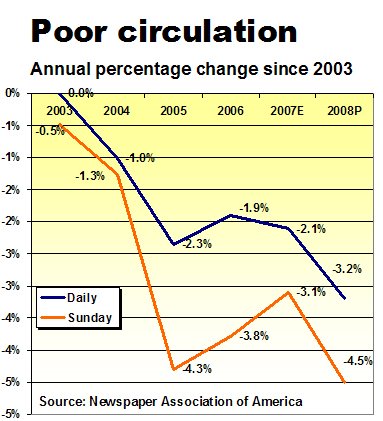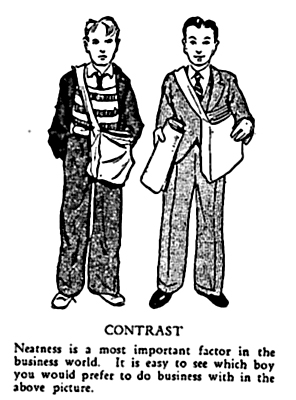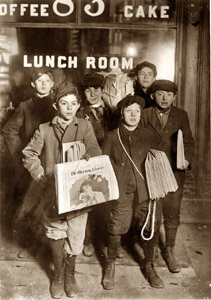The Invention of the Paperboy
Today, the invention of the paperboy. The Honors College at the University of Houston presents this program about the machines that make our civilization run, and the people whose ingenuity created them.
I'm only in my forties, but I recently discovered I'm a relic. You see, my working life started at age 13, when I began delivering the Kalamazoo Gazette. My paper route was a goldmine. Our neighborhood was classic suburban housing rolled over premium Michigan farmland. There were scads of tightly packed houses with no fence between them, and every one of them subscribed to the paper. It was hard work and a lot of walking — but obscenely lucrative for a young teenager.
The idea of the neighborhood paperboy dates back to the Great Depression. Before then, unkempt urchins hawked papers on street corners. These were "newsies," working class kids largely exploited by the industry. The Depression brought hard times for newspapers through a sudden loss of advertising revenue. Less money meant fewer resources to push circulation. This made publishers shift to a new strategy for cheap home delivery. Circulation managers drummed up a massive juvenile labor force with a new style and purpose. These were mostly middle-class teenagers, who could represent the paper on the doorstep of every American home. They sold subscriptions, not just individual papers.
The old newsies were tough kids, hollering and fighting their way to dominate a street corner. They worked long hours and strayed far from their neighborhoods. But the new paperboys were businessmen, establishing relationships in their own communities and working fixed routes with regular hours. This was all under the guidance of circulation managers, who looked after them — and kept after them. The new management system worked so well in the Depression that it went largely unchanged for half a century.
By WWII, the paperboy was such a common figure in America that the Treasury Department authorized them to sell War Savings Stamps. By war's end, they'd sold $1.7 billion worth. A few years later, the Post Office issued a commemorative stamp making the paperboy a true American icon: "newspaper-boys," it read, "standard bearers of free enterprise." The home delivery system grew like kudzu as middle-class life turned increasingly suburban. But little did I know as I tossed my papers in the 1970s, I was at the historical peak of the paperboy phenomenon.
By the 1980s, middle class women were going to work in larger numbers, and fewer were reading the afternoon paper. Grown-ups now had cable TV news to watch, and then came the real tidal wave: the Internet. But the youth culture changed too. Middle class kids were less motivated toward manual labor, and adults with cars began to take over the routes. 1984 revealed a telltale symptom of change: Atari released a video game called The Paperboy, in which players dodged perilous dogs and angry homeowners, and could even vandalize the homes of non-subscribers.
Increasingly, this was as close as most kids got to the real adventure of being a paperboy, where actual dogs bite you and flesh-and-blood grown-ups tell you to keep off the lawn. I guess I'll just have to get used to being a fading American icon. Don't forget us old veterans come Oct. 13. That's National Carrier Day!
I'm Richard Armstrong, at the University of Houston, where we're interested in the way inventive minds work.

Print Sources:
Michael Burgan, The American Newsboy (Compass Point Books, 2007). [Illustrated children's book from the series We The People.]
Henry Petroski, Paperboy: Confessions of a Future Engineer (Vintage Books, 2003).

This illustration from a Depression-era circulation manual instructs the paperboy on the importance of a middle-class appearance. (Reproduced in Postol [2000]:382.)
Todd Alexander Postol, "Creating the American Newspaper Boy: Middle-Class Route Service and Juvenile Salesmanship in the Great Depression," Journal of Social History 32:2 (1997):327-345.
"Masculine Guidance: Boys, Men, and Newspapers, 1930-1939," Enterprise & Society 1:2 (2000):355-390.
Online:
The current newspaper circulation crisis:
Louis Hau, "Timber! Newspaper Circulation Falls Again." Forbes.com, 04.28.08. Accessed June 5, 2008.
Paperboy decline in the US, 1987:
Switch to adult carriers, 1992:
Paperboy decline also hit the UK, but later than in the US:
Finlo Rohrer, "The Strange Decline of the Paperboy." BBC News Magazine. Accessed June 5, 2008.
Brooklyn newsies, 1908. Wikipedia Commons.
Miscellaneous:
Wikipedia entry on the Atari game The Paperboy.
Nostalgic blog reviewing the classic edition of the game The Paperboy
